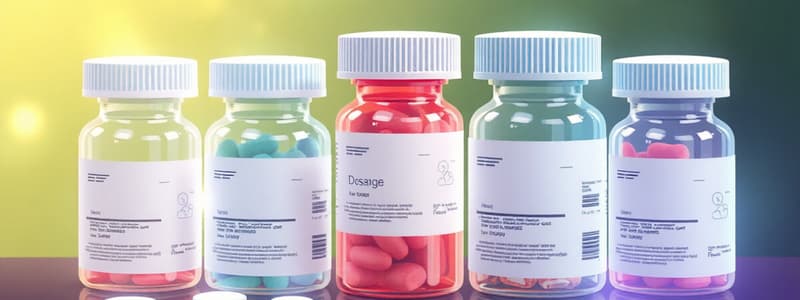Podcast
Questions and Answers
Which of the following is a characteristic of a coated tablet?
Which of the following is a characteristic of a coated tablet?
- It is only available in liquid form.
- It helps protect the drug and masks its bad taste. (correct)
- It is small and absorbable without any coating.
- It is primarily used for rectal administration.
What type of dosage form is an elixir?
What type of dosage form is an elixir?
- A drug mixed with an emulsifying agent.
- A solid pill meant to dissolve slowly.
- A capsule filled with liquid.
- A solution containing alcohol and water. (correct)
In what way do sustained release tablets differ from ordinary tablets?
In what way do sustained release tablets differ from ordinary tablets?
- They are coated with sugar.
- They contain only liquids.
- They provide both rapid onset and long duration of action. (correct)
- They dissolve completely in the stomach.
What is the primary purpose of enteric-coated tablets?
What is the primary purpose of enteric-coated tablets?
Which of the following is NOT a type of oral dosage form?
Which of the following is NOT a type of oral dosage form?
What is a primary purpose of a retention enema?
What is a primary purpose of a retention enema?
Which of the following is a characteristic of vials?
Which of the following is a characteristic of vials?
What must be done before administering a retention enema?
What must be done before administering a retention enema?
Which dosage form is used for drug delivery through inhalation?
Which dosage form is used for drug delivery through inhalation?
Which skin dosage form is suitable for treating wet lesions?
Which skin dosage form is suitable for treating wet lesions?
Flashcards
Evacuant Enema
Evacuant Enema
A type of enema used to empty the lower part of the gastrointestinal tract (GIT).
Retention Enema
Retention Enema
Enema used to deliver medication into the rectum.
Parenteral Dosage Forms
Parenteral Dosage Forms
Medication given by injection delivered directly into the bloodstream (e.g., injections).
Ampoule
Ampoule
A single-dose container for sterile liquid medication.
Signup and view all the flashcards
Vial
Vial
A multi-dose container for medication; may contain a solvent added before use for unstable drugs.
Signup and view all the flashcards
Oral Liquid Dosage Forms
Oral Liquid Dosage Forms
Liquid drug preparations taken by mouth, including solutions, syrups, elixirs, tinctures, suspensions, and emulsions.
Signup and view all the flashcards
Oral Solid Dosage Forms
Oral Solid Dosage Forms
Solid drug preparations taken by mouth, such as tablets, capsules, and lozenges.
Signup and view all the flashcards
Rectal Dosage Forms
Rectal Dosage Forms
Drug preparations administered through the rectum, including enemas and suppositories.
Signup and view all the flashcards
Tablet Types
Tablet Types
Tablets are solid dosage forms with various types, including ordinary, coated, sustained-release, enteric-coated, sublingual, and lozenges
Signup and view all the flashcards
Capsule Types
Capsule Types
Capsules are solid dosage forms enclosing a drug inside a gelatin shell. Including hard capsules, soft capsules, spansules and enteric coated capsules
Signup and view all the flashcardsStudy Notes
General Pharmacology: Dosage Forms of Drugs
- Learning Outcomes (LLOs): Students should be able to describe different oral, rectal, parenteral, inhalation, and topical dosage forms of drugs.
Enteral Dosage Forms
-
Oral Dosage Forms (Liquids):
- Solutions:
- Aqueous solutions: Volatile oils (e.g., peppermint water).
- Syrup: Sugar-saturated aqueous drug solutions (e.g., cough syrups).
- Aqueous extract: 100% concentrated drug extract in water.
- Alcoholic solutions:
- Spirit: Alcoholic solution of volatile oils.
- Elixir: Sweetened hydroalcoholic drug solution.
- Tincture: 10-20% concentrated drug extract in alcohol.
- Suspensions: Insoluble solid substances in water.
- Emulsions: Insoluble liquid substances suspended in water with an emulsifying agent (e.g., gum).
- Solutions:
-
Oral Dosage Forms (Solids):
- Tablets:
- Ordinary tablets: Compressed medicated powder mixed with inert binders (e.g., starch, lactose).
- Coated tablets: Sugar coating to mask bad taste.
- Sustained-release tablets (spansules): Multiple coats for controlled release and prolonged action.
- Tablets:
-
Types of Tablets:
- Compressed tablet
- Sugar-coated tablet
- Film-coated tablet
- Effervescent tablet
- Enteric-coated tablet
- Chewable tablet
-
Vaginal tablets: Examples include products like GYNO-TIOCOSID (ticonazole).
-
Implantation tablets: Example is IMPLANON (etonogestrel implant).
-
Lozenges/Troches: Products like Strepsils(for dry cough relief).
-
Hypodermic tablets: These can be injected or are intended for a certain area.
Rectal Dosage Forms
-
Liquid (Enema):
- Evacuant enema: Warm water (600 mL) given under high pressure.
- Retention enema: 100 mL given slowly under low pressure.
-
Solid (Suppository):
- The drug is incorporated into a waxy base.
- Evacuant enemas and glycerin suppositories evacuate the lower GIT.
- Medicated suppositories deliver drugs rectally.
- Precautions before retention enema:
- Rectum must be cleaned with an evacuant enema first.
- Amount must not exceed 200 mL.
- The level of the solution should not be high.
- The solution should not be irritating.
Parenteral Dosage Forms (Liquids)
- Injections:
- Ampoules: Single-dose vials of sterile solutions.
- Vials: Multi-dose sterile solutions.
Drugs Given By Inhalation
- Gases: Oxygen, anesthetics, highly volatile substances (e.g., amyl nitrite).
- Vapors: Highly volatile or less volatile substances (e.g., benzoin tincture).
- Aerosols: Liquid or solid suspensions in gas.
- Nebulizer: Depending on pressurized air or oxygen creates mist to deliver a drug via inhalation.
- Inhaler: Drug is combined with a propellant substance. Amount is limited by both the toxicity of the drug and the additives in the inhaler.
Skin Dosage Forms
- Liquids:
- Lotion: Aqueous solution for topical use.
- Liniment: Alcoholic solution for topical use.
- Semisolid:
- Cream: Oil-in-water emulsion.
- Ointment: Water-in-oil emulsion (higher oil content).
- Pastes: Mixture of powders and ointment.
- Solid:
- Patches: Drug-containing adhesive patches.
Studying That Suits You
Use AI to generate personalized quizzes and flashcards to suit your learning preferences.




